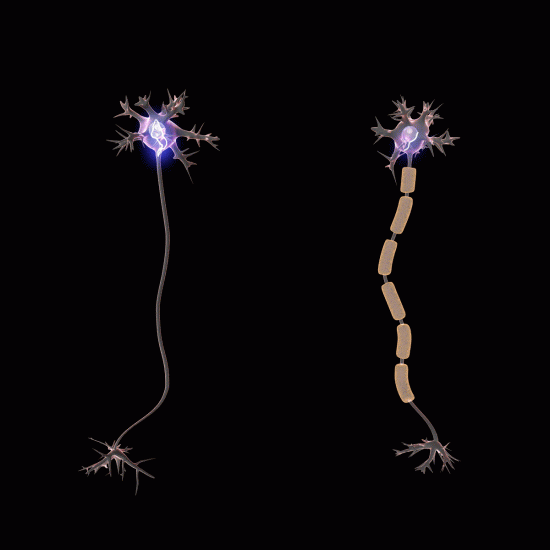Myelin Sheath Definition
The myelin sheath is a fatty insulating later that surrounds the nerve cells of jawed vertebrates, or gnathostomes. All extant members of the Gnathostomata, from fish to humans, have a myelin sheath on the axon of their nerve cells. The oldest known members of the jawed fishes, the exinct placoderms, were armored fishes that appear to have more primitive nerves which are not covered in myelin sheaths. Soft tissues of a placoderm were found preserved in an organism which lived over 400 million years ago in the late Devonian period in Australia. Current evidence suggests that the myelin sheath evolved sometime after this, as the current lineage of vertebrates diverged from the armored placoderms. Some invertebrates have developed substances similar to the myelin sheath, which serve a similar function.
Myelin sheath is produced in a process called myelination, in which can be seen in the image above. The myelin sheath of nerve cells is typically produced early in development. Special cells called oligodendrocytes or Schwann cells create and store large amounts of myelin. The oligodendrocytes then wrap themselves around the axon of a nerve cell. Many oligodendrocytes are needed to cover the long axons in mammals, which can be up to a meter long. By itself, myelin is a fatty substance that appears white. In parts of the brain and nervous system called white matter there is an excess of myelin sheath. In grey matter, more cell bodies are present. Myelin is chemically composed of various lipids and proteins, which also absorb some water.
Some degenerative diseases, like multiple sclerosis, result in the degradation of the myelin sheath. This can lead to a wide number of side effects, and eventually total paralysis and death. The myelin sheath is needed to insulate nerves from each other and to speed the time signals pass along long nerves. Without this functions, signals become mixed and normal movements become impossible. Blindness, and other neurological conditions related to nerve damage occur when the myelin sheath is removed.
Function of the Myelin Sheath
The myelin sheath has a number of function in the nervous system. The main functions include protecting the nerves from other electrical impulses, and speeding the time it takes for a nerve to traverse an axon. Unmyelinated nerves must send a wave down the entire length of the nerve. In large organisms, this presents a problem, as the signal takes a long time to reach the end of the nerve. Due to salutatory conduction, the individual myelin sheaths cause the signal to leap from one node of Ranvier to the next. The myelin sheath does not allow the action potential to form where it covers the axon. Instead, the electrical wave created at each node propels the action potential to the end the nerve, were it can be transferred to the next neuron. This mode of propagating a signal down the axon also saves energy, as the sodium and potassium pumps that regulate the action potential are not needed under the myelin sheath. Although the myelin sheath is seen only in vertebrates, salutatory conduction is seen in many animals. This phenomena can be seen in the graphic below.
Related Biology Terms
- Neuron – A nerve cell, which carries a signal to other nerve cells in the nervous system.
- Axon – The long extensions of neurons which carry nerve impulses to the next neuron.
- Dendrite – A small structure neurons use to communicate with each other.
- Node of Ranvier – Small spaces between separate cells of the myelin sheath.
Quiz
1. In degenerative nerve diseases, the myelin sheath is lost and it produces a number of symptoms. Many of these symptoms can progress to paralysis and death. Why can some organisms exist with no myelin sheath, and still function?
A. They are evolutionarily adapted to function without myelin.
B. These organisms must move and function at a slower rate than humans.
C. Nerve cells must be myelinated to function.
2. Pregnant mothers are often told to eat lots of “good fats” like nuts and avocados, to aid their child’s brain development. Why is fat needed during brain development?
A. To create myelin sheaths.
B. To keep nerve cells nice and plump.
C. To separate nerve cells from one another.
3. Why is the speed at which signals are conducted important?
A. Some organisms must coordinate body parts far apart from each other.
B. Faster signals mean faster organisms.
C. More intelligent organisms conduct signals at high speeds.


